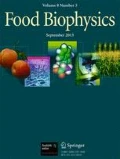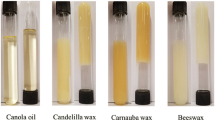Abstract
In this research, we studied the relationship between the molecular structure of (R)-12-hydroxyoctadecanamide, (R)-N-propyl-12-hydroxyoctadecanamide, and (R)-N-octadecyl-12-hydroxyoctadecanamide and the thermo-mechanical properties of their 2% (wt/wt) organogels developed using safflower oil high in oleic acid (HOSFO) as the liquid phase. Candelilla wax (CW), a well-known edible gelling additive whose main component is hentriacontane, also was studied for comparative purposes. The results obtained show that the attractive interactions (i.e., hydrogen bonding and dipolar interactions) between amide groups and between hydroxyl groups present in the amides resulted in organogels with higher melting temperature, heat of melting, and crystallization parameters than those found in the CW organogel. The rheological parameters associated to the strength of the amide or CW-based gels developed in HOSFO (i.e., yield stress and elastic modulus) seem to be associated with the nature of amide groups (i.e., primary or secondary amide) and the increase in the length of the self-assembly molecular unit (i.e., L value determined by X-ray diffraction) and therefore to the extent of London dispersion forces along the hydrocarbon chain. The creep and recovery measurements allowed an evaluation among the internal structures of the different organogels and demonstrated that independent of the hydrogen bonding and dipolar interaction provided by the amide and the hydroxyl groups, the increase in the hydrocarbon chain length results in higher organogel resistance to deformation and higher instant recovery capacity. However, the stabilization of the self-assembly unit through polar groups (i.e., –CONH2 in HOA) reduces organogel elasticity but provides a higher extended recovery capacity. The results reported in this investigation showed some relationships between gelator structure and the thermo-mechanical properties of low-molecular-mass organic gelator amides. Our long-term objective is to understand the organogelation process to eventually develop trans-free vegetable oil-based food products with novel textures for the consumers.






Similar content being viewed by others
References
D.J. Abdallah, R.G. Weiss, n-Alkanes gel n-alkanes (and many other organic liquids). Langmuir. 16, 352–355 (2000). doi:10.1021/1a990795r
E. Ostuni, P. Kamaras, R.G. Weiss, Novel X-ray method for in situ determination of gelator strand structure: polymorphism of cholesteryl anthraquinone-2-carboxylate. Angew. Chem. Int. Ed Engl. 35, 1324–1326 (1996). doi:10.1002/anie.199613241
A. Bot, G.M. Agterof, Structuring of edible oils by mixtures of γ-oryzanol with β-sitosterol or related phytosterols. J. Am. Oil Chem. Soc. 83, 513–521 (2006). doi:10.1007/s11746-006-1234-7
R. Kumar, O.P. Katare, Lecithin organogels as a potential phospholipid-structured system for topical drug delivery: a review. AAPS PharmSciTech. 6, E298–E310 (2005). doi:10.1208/pt060240
S. Murdan, G. Gregoriadis, A.T. Florence, Novel sorbitan monostearate organogels. J. Phar. Sci. 88, 608–614 (2000). doi:10.1021/js980342r
D.J. Abdallah, L. Lu, R.G. Weiss, Thermoreversible organogels from alkane gelators with one heteroatom. Chem. Mater. 11, 2907–2911 (1999). doi:10.1021/cm9902826
H. Takeno, T. Mochizuki, K. Yoshiba, S. Kondo, T. Dobashi, Self-assembling structures and sol–gel transition of optically active and racemic 12-hydroxystearic acids in organic solvents. Progr. Colloid. Polym. Sci. 136, 47–54 (2009). doi:10.1007/2882_2009_7
V.A. Mallia, M. George, D.L. Blair, R.G. Weiss, Robust organogels from nitrogen-containing derivatives of (R)-12-hydroxystearic acid as gelators: comparisons with gels from stearic acid derivatives. Langmuir. 25, 8615–8625 (2009). doi:10.1021/la8042439
P. Terech, R.G. Weiss, Low molecular mass gelators of organic liquids and the properties of their gels. Chem. Rev. 97, 3133–3159 (1997). doi:10.1021/cr9700282
R.G. Weiss, P. Terech, Molecular Gels: Materials with Self-Assembled Fibrillar Networks (Springer, Dordrecht, 2006), pp. 449–551
J.F. Toro-Vazquez, J.A. Morales-Rueda, E. Dibildox-Alvarado, M.A. Charó-Alonso, M. Alonzo-Macías, M.M. González-Chávez, Development of organogels with candelilla wax and safflower oil with high triolein content. J. Am. Oil Chem. Soc. 84, 989–1000 (2007). doi:10.1007/s11746-007-1139-0
J.A. Morales-Rueda, E. Dibildox-Alvarado, M. Charó-Alonso, R.G. Weiss, J.F. Toro-Vazquez, Thermo-mechanical properties of candelilla wax and dotriacontane organogels in safflower oil. Europ. J. Lipid. Sci. Technol. 111, 207–215 (2009). doi:10.1002/ejlt.200810174
J.A. Morales-Rueda, E. Dibildox-Alvarado, M.A. Charó-Alonso, J.F. Toro-Vazquez, Rheological properties of candelilla wax and dotriacontane organogels measured with a true-gap system. J. Am. Oil Chem. Soc. 86, 765–772 (2009). doi:10.1007/s11746-009-1414-3
M. Dolz, M.J. Hernández, J. Delegido, Creep and recovery experimental investigation of low oil content food emulsions. Food Hydrocolloids. 22, 421–427 (2008). doi:10.1016/j.foodhyd.2006.12.011
D.J. Abdallah, S.A. Sirchio, R.G. Weiss, Hexatriacontane organogels. The first determination of the conformation and molecular packing of a low-molecular-mass organogelator in its gelled state. Langmuir. 16, 7558–7561 (2000). doi:10.1021/la000730k
J.F. Steffe, Rheological Methods in Food Process Engineering, 2nd edn. (Freeman, East Lansing, 1996), pp. 304–310
The AOCS Lipid Library. Anandamide, oleamide and other simple fatty amides structure, occurrence, biology and analysis. http://lipidlibrary.aocs.org/Lipids/amides/index.htm
J. Joseph, B. Niggemann, K.S. Zaenker, F. Entschladen, Anandamide is an endogenous inhibitor for the migration of tumor cells and T lymphocytes. Cancer Immunol. Immunother. 53, 723–728 (2004). doi:10.1007/s00262-004-0509-9
S. Huitrón-Reséndiz, L. Gombart, B.F. Cravatt, S.J. Henriksen, Effect of oleamide on sleep and its relationship to blood pressure, body temperature, and locomotor activity in rats. Exp. Neurol. 72, 235–243 (2001). doi:10.1006/exnr.2001.7792
Acknowledgments
The investigation was supported by grant no. 25706 from CONACYT. The technical support from Concepcion Maza-Moheno and Elizabeth Garcia-Leos is greatly appreciated. V. Ajay Mallia and Richard G. Weiss thank the U.S. National Science Foundation for its support of the research performed at Georgetown.
Author information
Authors and Affiliations
Corresponding author
Rights and permissions
About this article
Cite this article
Toro-Vazquez, J.F., Morales-Rueda, J., Mallia, V.A. et al. Relationship Between Molecular Structure and Thermo-mechanical Properties of Candelilla Wax and Amides Derived from (R)-12-Hydroxystearic Acid as Gelators of Safflower Oil. Food Biophysics 5, 193–202 (2010). https://doi.org/10.1007/s11483-010-9159-y
Published:
Issue Date:
DOI: https://doi.org/10.1007/s11483-010-9159-y




